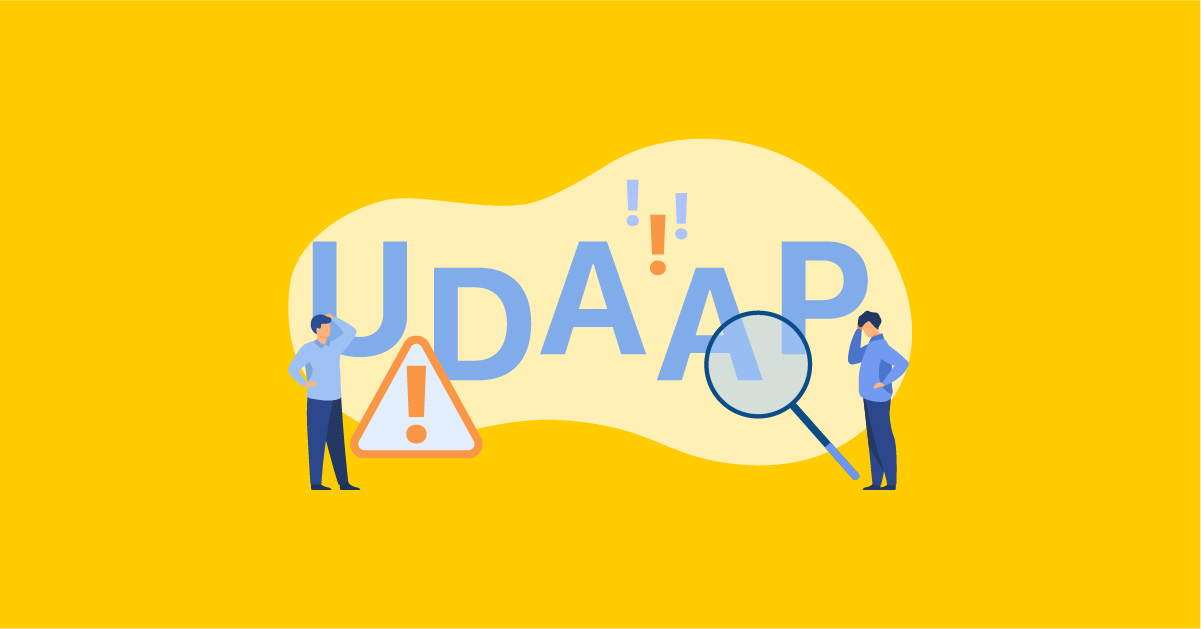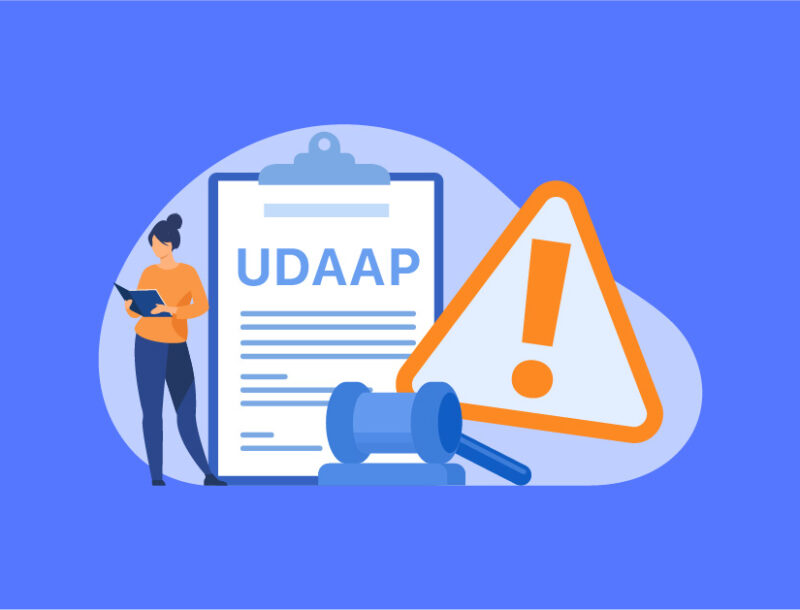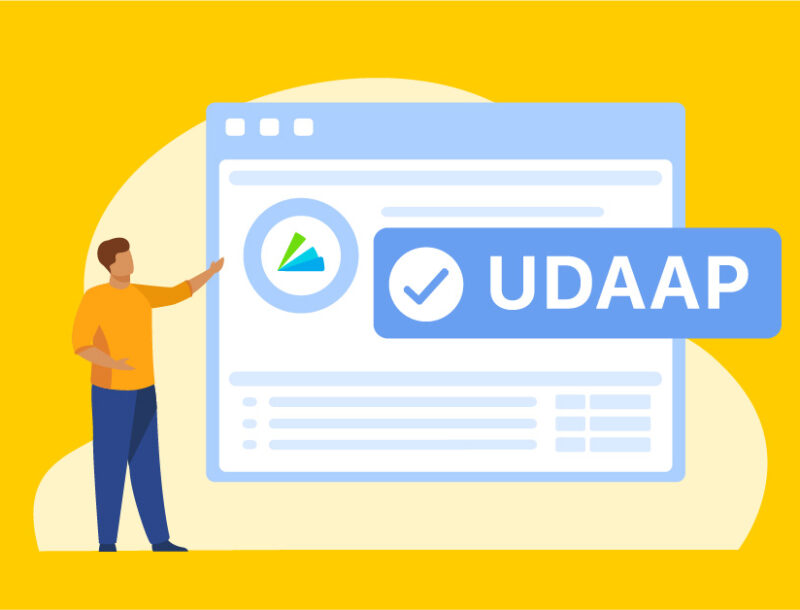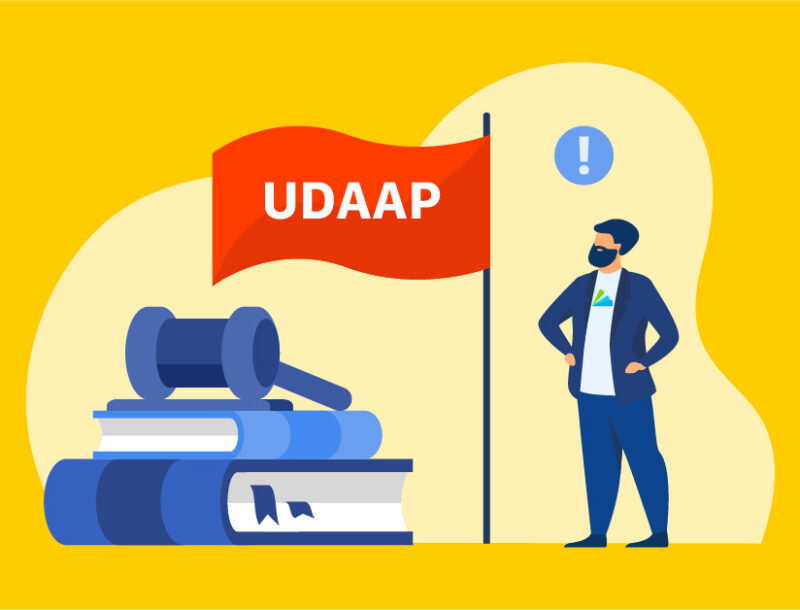Guide to UDAAP, What You Need To Know

Overview: What UDAAP Means & Why It Matters
UDAAP stands for Unfair, Deceptive, or Abusive Acts or Practices. These are prohibited behaviors that financial institutions and service providers cannot engage in when offering or marketing products and services.
The intent of UDAAP is straightforward: safeguard consumers, reduce financial harm, and create a level playing field in the financial marketplace. Without these protections, consumers could be left vulnerable to misleading offers, hidden fees, or aggressive sales tactics that undermine trust in the financial system.
In practice, UDAAP compliance is about balancing consumer protection with business objectives while minimizing enforcement risk.
- The Legal Foundation: Laws, Regulations, and Rulemaking
- Who UDAAP Applies To: Covered Businesses and Sectors
- UDAAP in Banking and Mortgages
- The Elements and Tests: Unfair, Deceptive, Abusive
- Abusive in Focus: Real-World Edge Cases
- Real-World Scenarios of UDAAP Violations
- Building a UDAAP Compliance Program That Works
- Digital Marketing and UDAAP
- Enforcement and Consequences
- Definitions and Quick Answers
- Practical UDAAP Checklist
The Legal Foundation: Laws, Regulations, and Rulemaking
The modern framework for UDAAP originates with the Dodd-Frank Act, specifically sections 1031 and 1036, which explicitly prohibit unfair, deceptive, or abusive acts. The Consumer Financial Protection Bureau (CFPB) was granted broad authority to define, investigate, and enforce UDAAP.
UDAAP also builds on UDAP, a longstanding standard under the Federal Trade Commission Act. While UDAP covers unfair or deceptive practices, the Dodd-Frank Act added the “abusive” standard to capture conduct that interferes with consumer understanding or takes unreasonable advantage of consumers.
Enforcement is shared across agencies:
- CFPB oversees most consumer financial products and services.
- FTC enforces UDAP standards for non-bank financial institutions.
- OCC, Federal Reserve, and FDIC oversee banks and credit unions.
- State regulators and attorneys general enforce at the state level.
Importantly, UDAAP guidance is not limited to laws. Examiners also rely on manuals, supervisory guidance, and examination procedures, which outline how practices are reviewed in real-world settings.
Who UDAAP Applies To: Covered Businesses and Sectors
UDAAP applies broadly to entities engaged in the consumer financial sector, including:
- Banks and credit unions
- Mortgage lenders and servicers
- Non-bank financial firms such as debt collectors and credit reporting agencies
- Third-party service providers acting on behalf of financial institutions
If your business engages directly or indirectly with consumers in a financial capacity, UDAAP applies.
UDAAP in Banking and Mortgages
The banking and mortgage industries are frequent focal points for UDAAP examinations. Common risk areas include:
- Banking: overdraft programs, fee disclosures, misleading promotional offers, collections, and servicing practices.
- Mortgages: unclear advertising, hidden fees in loan origination, misleading rate disclosures, servicing errors, and foreclosure practices.
These sectors are heavily scrutinized because the products are complex and the potential for consumer harm is high.
The Elements and Tests: Unfair, Deceptive, Abusive
Each component of UDAAP has its own legal test:
- Unfair: Causes substantial injury, not reasonably avoidable by consumers, and not outweighed by countervailing benefits.
- Deceptive: Likely to mislead a reasonable consumer and the misrepresentation is material.
- Abusive: Interferes with consumer understanding or takes unreasonable advantage of their lack of knowledge, inability to protect themselves, or reliance on the provider.
These elements give examiners the tools to judge whether a product, disclosure, or practice crosses the line.
Abusive in Focus: Real-World Edge Cases
“Abusive” is often the most debated element. Examples include:
- Material interference: Complex contracts or “dark patterns” that make it difficult for consumers to understand key terms.
- Unreasonable advantage: Targeting consumers who lack financial literacy or placing them in products they cannot reasonably afford.
The 4Ps of UDAAP: A Disclosure Clarity Test
Regulators often apply the 4Ps test when examining disclosures:
- Prominence: Is the disclosure large or clear enough to be noticed?
- Presentation: Is the language simple and straightforward?
- Placement: Is it positioned where consumers naturally look?
- Proximity: Is it near the claim it qualifies, not separated by distance or distraction?
Even technically correct disclosures can still be deemed deceptive if they fail one of these four standards.
How Regulators Investigate Possible UDAAP Violations
When examiners investigate, they evaluate the entire consumer experience. That means reviewing:
- Company policies and internal controls
- Employee training and incentive programs
- Complaint data and trends
- Marketing and disclosures
- Third-party relationships and oversight
Complaints, in particular, serve as red flags. Examiners use them to spot recurring issues that could indicate systemic unfair, deceptive, or abusive acts.
Real-World Scenarios of UDAAP Violations
Here are a few examples examiners frequently cite:
- Deceptive: Advertising a “fixed low rate” but failing to disclose high fees.
- Unfair: Structuring products so that back-end fees create unavoidable consumer harm.
- Abusive: Promoting an introductory offer that conceals dramatic cost increases later.
For a deeper breakdown, see these examples of UDAAP violations from PerformLine.
Building a UDAAP Compliance Program That Works
Strong compliance programs are proactive, not reactive. Key practices include:
- Documenting a clear UDAAP policy
- Conducting regular risk assessments
- Providing ongoing employee training across all roles
- Reviewing marketing and disclosures before publication
- Proactively monitoring marketing content across consumer channels like, websites, social posts,and emails to find and mitigate issues
- Structuring compensation programs that do not incentivize harmful behavior
- Enforcing strict vendor oversight with audits and SLAs
- Managing complaints to identify root causes and remediate issues
These steps not only reduce enforcement risk but also build consumer trust.
Digital Marketing and UDAAP
In the digital era, compliance extends beyond brochures and contracts. Disclosures must be clear across:
- Websites and landing pages
- Email campaigns and SMS
- Social media promotions
- In-app messages and push notifications
Poor placement, unreadable fine print, or contradictory messaging can all trigger UDAAP violations.
Enforcement and Consequences
Non-compliance carries serious consequences. Regulators can issue civil penalties, restitution orders, and public enforcement actions. Beyond financial costs, reputational harm can reduce consumer confidence and invite further scrutiny.
UDAAP violations may also overlap with laws like TILA, ECOA, FCRA, FDCPA, and privacy regulations, compounding risk.
Definitions and Quick Answers
- UDAAP: Unfair, Deceptive, or Abusive Acts or Practices.
- UDAAP compliance: Processes and controls that prevent consumer harm in financial products and services.
- Abusive definition: Practices that interfere with consumer understanding or exploit them unfairly.
- Who implements UDAAP: Primarily the CFPB, supported by the FTC, OCC, FDIC, and state regulators.
FAQs About UDAAP
Prominence, Presentation, Placement, and Proximity. These ensure disclosures are effective and not misleading.
Unfair, deceptive, and abusive acts.
A federal consumer protection standard preventing harmful practices in financial services.
Misleading rate claims, hidden fees, aggressive collection tactics, and failure to disclose costs are frequent examples of common UDAAP violations.
Patterns of consumer complaints, concerning exam findings, or marketing practices that appear misleading.
Practical UDAAP Checklist
- Marketing and disclosures: Review disclosures for clarity and proximity.
- Product design: Ensure products do not rely on hidden or back-end fees.
- Servicing and collections: Monitor servicing and collections for fairness.
- Third-party oversight: Audit third-party vendors regularly.
- Complaints: Track complaints and resolve systemic issues.


